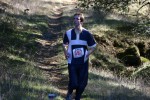Spring Lake Regional Park
Date: (Sun.) May. 6, 2012
Location: Santa Rosa, CA
Event Director: Judy Koehler - 707.778.1604
Course Setters: Brett Carver, Erik Carver, Bill Cusworth (NAV-X), Heidi Cusworth (NAV-X)
Type: C; Courses for beginners, as well as something interesting for intermediate and advanced orienteers
Course Setters' Notes
By Bill & Heidi Cusworth
Spring Lake Regional Park, in eastern Santa Rosa, is a beautiful place to go orienteering. Unfortunately, the map is very out of date, with the exception of the area west of Spring Lake that was updated two years ago. Many of the control locations that we wanted to use were unsuitable either due to the poor map or the presence of poison oak. We updated the map around the control locations on the eastern and southern parts of the map to maintain some level of fairness, but the whole map needs to be redone in the future.
For this event, standard courses will be used with manual punching — no SI sticks required.
Courses
Here are the course statistics:
Course Length Climb Controls Difficulty
White 2.5 km 45 m 11 Novice
Yellow 3.7 km 120 m 14 Beginner
Short Orange 4.3 km 105 m 15 Intermediate
Long Orange 6.1 km 225 m 24 Intermediate
Beginners should keep in mind that the lengths listed represent the total of the straight-line distances between controls. The actual distance traveled on a course will always be longer — how much longer will depend on route choices and errors.
The White and Yellow courses are printed at 1:5000, so it should be easier for beginners to read the maps. The Orange courses are printed at 1:7500, and I want to point out that this means the symbol sizes are smaller than standard, because of the reduction from the native 1:5000 map scale. This makes the map a little difficult to read the small details (especially small trails), but it shouldn't be too much trouble for an experienced orienteer.
The Orange courses were designed by Bill & Heidi Cusworth. The White and Yellow courses were designed by Brett Carver with assistance from Bill & Heidi.
For this year’s event, we decided to use the big hill in the eastern part of the map. This hill has not been used for several years due to the high level of poison oak. However, we were able to find some control locations that avoid the poison oak so we could use the hill to mix things up. Use of this hill adds length to the Long Orange course, which should make it well worth the drive for many BAOC members. The Short Orange course is just a shortened version of the Long Orange course, skipping the hill, and thus it’s relatively flat.
Both Orange courses make a complete loop around the lake, while the White and Yellow courses will stick to the east and west sides of the south end of the lake. The Yellow and Orange courses don’t share very many controls, and thus would be good to do as a double.
We hope you come out and enjoy orienteering at Spring Lake!
BayONet Discussion
Before the event, there was a discussion on the BayONet (http://groups.yahoo.com/group/baoc/) about the courses at Spring Lake — basically regarding how advanced the Orange courses were going to be. Here is the response from Bill Cusworth, one of the course setters:
"OK, here is the deal with the Spring Lake courses. Our main goal was to set as long a course as possible to make it worthwhile for the long drive. We had intended the long course to be advanced difficulty, but we quickly determined that it would not be possible because most of the park is not mapped well. The area that was remapped for the team trial sprints on the west side of the lake is pretty good (although I did adjust a few trails), but the east side of the lake has not been remapped in quite some time (I did some minor map fixes near the controls). In addition, we decided to use a big hill on the east side of the lake that had not been used in years. The hill is covered with poison oak so we had to move controls closer to the trail to avoid it. So, in the end, we ended up with a course that is pretty easy in the beginning (east side of lake), leaning toward yellow difficulty in the some places and then gets harder, closer to advanced difficulty at the end of the course (west side of lake). So Orange (intermediate) difficulty really expresses the average difficulty of the course. I wouldn't say that the course is the most difficult possible, but it was the closest we could do and still have a fair course and use the whole area. The Short Orange is just a shortened version of the Long Orange for those who want to avoid the big hill. I hope this helps clear things up, and I look forward to seeing some club regulars at Spring Lake."

